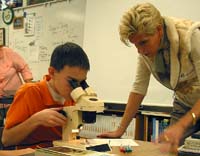Students Experience Real Science and Help Solve Community Problems
Students Experience Real Science and Help Solve Community Problems


Students study the lifecycle of the ETC in-depth.
In 2001 Mare Reproductive Loss Syndrome derailed the horse industry and puzzled scientists. Over the past 3 years, many strides have been made in finding the answers to the mystery.
Students at three central Kentucky schools are experiencing real science while helping the University of Kentucky College of Agriculture, their community and the horse industry. They are learning more than a textbook could teach them.
“Most of the time our kids learn science from a textbook and that might be necessary, but it’s just not sufficient,” said Carol Hanley, Extension specialist for 4-H youth development at the University of Kentucky College of Agriculture. “Science is wondering and problem solving.”
Science teachers involved in the project are excited about having real life situations that their students can learn from and even contribute to in the future.
“This project is true science,” said Susan Powers, science teacher at Winburn Middle School. “Their research will teach them how the Eastern Tent Caterpillar affected MRLS and eventually they may be able to tell farmers if it is a year they need to be spraying or things they need to look for. Hopefully there will be a trend over the years that the kids help to predict and hopefully we’ll get some science career interest from this.”
Students at Winburn Middle School and Tates Creek High School in Lexington and West Jessamine High School in Nicholasville are helping UK scientists by identifying cherry trees in Fayette County and other parts of central Kentucky. In late winter and early spring, they will examine the trees again and look for signs of the Eastern Tent Caterpillar. Their findings will be put into databases in hopes of determining population patterns of the caterpillar. UK Entomologist Bruce Webb will examine the data.
“Bruce Webb wanted to get the schools involved and he wants them to provide data about what’s happening with the ETC population and he wants to know if we can get enough data to predict trends.” Hanley said. “I want something entirely different from the project. I want the kids to be able to communicate science and put themselves in the role of a scientist. I want them to understand that there are problems in the community that they can help solve. UK is part of that community and we need to work together.”
As part of the year-long project, students have been learning about MRLS, cherry trees and the lifecycle of the ETC. They feel they are contributing to their community and helping to save an important contributor to the Kentucky economy.
“Maybe we’ll be able to warn horse owners if we see a spike in caterpillar numbers so they can keep their horses safe,” said Jack Fogle, eighth-grade student at Winburn.
Hanley and Powers hope the project can continue in the future and really contribute to answers in the ongoing MRLS investigation and also provide a powerful learning tool for students. She hopes the project can set an example for other schools in Kentucky.
“The Kentucky Department of Education would like to use this as a model for how to get teachers and students involved in solving community problems,” Hanley said.
The program is sponsored by a grant from the U.S. Department of Agriculture.
